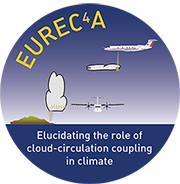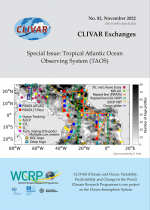ATOMIC and EUREC4A-OA have been endorsed by CLIVAR

Two international initiatives for the Tropical Ocean-Atmosphere Interactions at the Ocean Mesoscale have been endorsed by CLIVAR SSG recently:
1. Atlantic Tradewind Ocean-Atmosphere Mesoscale Interaction Campaign (ATOMIC, US)
2. Ocean-Atmosphere component of EUREC4A (EUREC4A-OA, Europe)
http://eurec4a.eu/index.php?id=5011
The Atlantic Tradewind Ocean-Atmosphere Mesoscale Interaction Campaign (ATOMIC, US) and the Ocean-Atmosphere component of EUREC4A (EUREC4A-OA, Europe) initiatives will take advantage of the complementary existing international EUREC4A intensive atmospheric field campaigns, to address the Northwest Tropical Atlantic Ocean-atmosphere interactions at the mesoscale and their relation to the regional OBL, air-sea interactions and atmospheric shallow-convection. Elucidating the Role of Cloud-Circulation Coupling in Climate (EUREC4A), the Field Study, is a French-German initiative in support of the World Climate Research Programme (WCRP)'s Grand Science Challenge on Clouds, Circulation and Climate Sensitivity and has been officially endorsed by WCRP in April 2018.
The ATOMIC & EUREC4A-OA program will feature a two-month field observation in the January-March 2020 time frame, with the central measurement period being between 20 Jan. and 20 Feb, 2020, combined with extensive process-level ocean and atmosphere (uncoupled and coupled) with linkages to operational Numerical Weather Predictions (NWP) centers and climate model centers. The overall period of the two projects will be 4 years beginning in 2019. The ATOMIC & EUREC4A-OA will take advantage of the complementary existing international EUREC4A intensive atmospheric field campaigns to address the Northwest Tropical Atlantic Ocean-Atmosphere interactions at the mesoscale and their relation to the regional Ocean Boundary Layer, air-sea interactions and atmospheric shallow-convection. It will add airborne and shipborne observing systems that complement EUREC4A. The shipborne work will focus on the role of eddies, barrier layers, and surface forcing on oceanic boundary-layer mixing. The oceanic work will benefit from and require the unprecedented surface forcing information provided by the large scale atmospheric array and from direct flux observations from ships.. In particular, ATOMIC & EUREC4A-OA will focus on:
- tropical ocean-atmosphere interactions at the ocean mesoscale (10-500 km), and assess the impact of the air-sea coupling on both the ocean and atmosphere at this spatial scale, and
- the multi-scale modeling of the atmosphere and of ocean-atmosphere coupling.
The ATOMIC & EUREC4A measurement will provide a benchmark data set for constraining a new generation of coupled models capable of resolving convective heat transport in the atmosphere, and meso- to sub-mesoscale variability in the ocean. Improved knowledge and model representations of the interaction of cumulus clouds with the atmospheric and oceanic boundary layers resulting from ATOMIC and EUREC4A-OA, have the potential to tap unrealized predictability in the climate system and thereby improve seasonal to subseasonal weather and climate prediction.
ATOMIC & EUREC4A-OA will contribute to the WCRP grand challenge on Clouds Circulation and Climate Sensitivity, and are directly and/or indirectly related to numerous CLIVAR goals and activities. Specifically, CLIVAR has just started to explore possibilities for an initiative on mesoscale oceanic eddies (www.clivar.org/events/ocean-mesoscale-eddy-interactions-atmosphereworkshop). The large internationally coordinated projects as ATOMIC and EUREC4A-OA, will also advance our understanding of the coupled system at the ocean mesoscale, and mesoscale oceanography in its own right, which has the potential to cooperate with CLIVAR ARP, PRP, IORP, OMDP and EBUS RF on the research of Ocean Mesoscale Eddy Interactions with the Atmosphere. Clearly ATOMIC & EUREC4A-OA will be an important element to consider the future Tropical Atlantic Observing System (TAOS), which is currently under review by ARP. The CLIVAR endorsement will also benefit to the proposed projects in particular in terms of resource mobilisation from participating countries.
Financial implications:
- German Cost Estimates
The German tam have already obtained the ship time and costs coverage for at least one ship (R/V Meteor). The availability of the R/V Merian is still pending. The cost of data validation, calibration and analyses will be covered by in-kind sources (GEOMAR and Max-Plank Institute of Meteorology) and additional external funding. Funding for ground based measurements and at least one aircraft has also been secured; this alone amounts to about 5 M€. Additional funding for the ship deployments, in-kind support for the modeling studies, and subsequent analysis will bring the German contribution to nearer 10 M€.
- US Cost Estimates
The US team is pursuing an initiative within NOAA to participate in the project. If fully successful, NOAA would provide the R/V Ronald H. Brown (30 days, 850* USk$), the G-4 aircraft (120 hrs, 350 dropsondes, 850* USk$), and the P-3 aircraft (120 hrs, 50 dropsondes, 850* USk$). NOAA’s Climate Variability (CVP) program and NOAA’s Office of Weather and Air Quality (OWAQ) have been approached to offer a request for proposals for NOAA and non-NOAA scientists to participate in ATOMIC. We anticipate that university investigators would also propose to NSF to be involved in the field program or the modeling efforts. To fully utilize the US platforms would require on the order of 3-5 m$/yr for three years of joint NOAA/NSF funding plus 1-2 m$/yr in NOAA’s research laboratory funds (including about 0.7 m$ for two month deployment of Saildrones and Oculus gliders).
- French Cost Estimates
The French EUREC4A team is funded through a European Research Council grant. It has submitted a pre-request of the R/V Thalassa or Atalante whose availability is still pending. National grant proposals have been and will be submitted in the coming months to INSU-CNRS and ANR to complement the costs for the cruises, additional equipment, data processing and analyses as well as modeling experiments and parameterization studies. Present French funding is in the order of 3 M€.
List of the project's Scientific Steering Committee
- ATOMIC (Atlantic Tradewind Ocean-Atmosphere Mesoscale Interaction Campaign)
USA: C.W. Fairall, P. Zuidema, K. Emanuel, M. Zhao, R. C. Perez, S. Bigorre, Chidong Zhang, J. Thomson, R. Pincus, J. Olson, G. Feingold, C-A Clayson, S. de Szoeke, Jerome Schmidt
- EUREC4A-OA (EUREC4A Ocean & Atmosphere component)
France: S. Speich, H. Bellanger, G. Reverdin, S. Bony, B. Deremble, J.-L. Dufresne, F. Hourdin, I. Musat, C. Muller, R. Vogel, F. Beucher, D. Bouniol, F. Burnet, G. Canut, F.Couvreux, C. Denjean, G. Faure, H. Giordani, R. Honnert, C. Lac, G. Roberts, R. Roehrig
Germany: J. Karstensen, M. Dengler, W. Mohr, F. Ament, G. Bagheri , E. Bodenschatz, S. Buehler, S. Crewell, C. Klepp, S. Gross., C. Hohenegger, S. Kinne, D. Klocke, P. Landschützer, AK Naumann, M. Pöhlker, B. Mayer, M. Sakradzija, B. Stevens M. Wendisch, H. Kalesse
Other EU partners: L. Nuijens and P. Siebesma (U Delft), I. Sandu (ECMWF), S. Malinowski (U. Warsaw), M. Jochem (Niels Bohr Institute). A. Blyth (Leeds), B. Webber (E.Anglia), J. Piskozub (Sopot, PO)
For more information of CLIVAR endorsement projects and activities, please click here.













